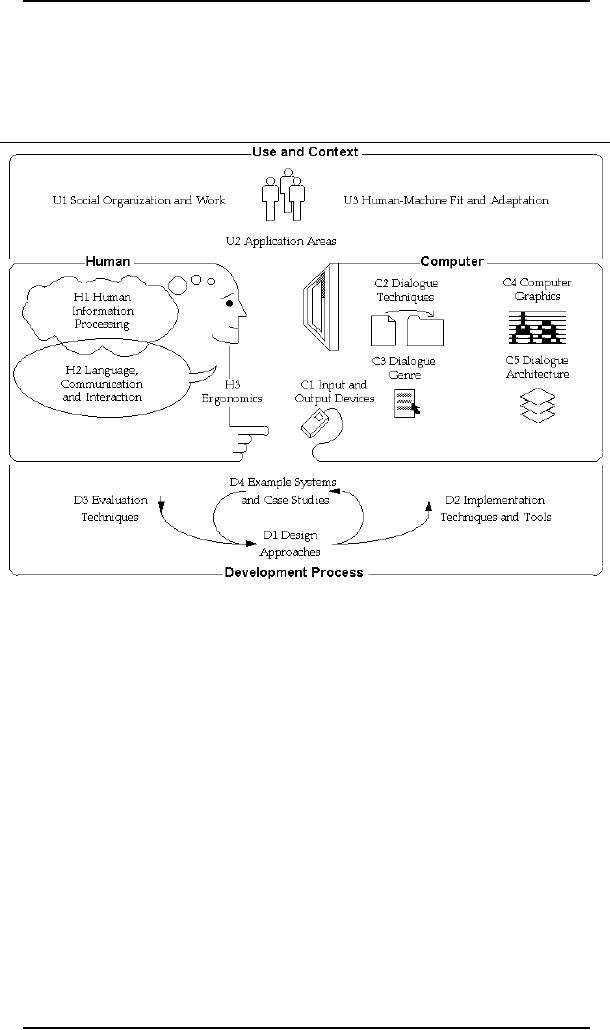 |
DISCIPLINE OF HUMAN COMPUTER INTERACTION |
| << GOALS & EVOLUTION OF HUMAN COMPUTER INTERACTION |
| COGNITIVE FRAMEWORKS: MODES OF COGNITION, HUMAN PROCESSOR MODEL, GOMS >> |

Human
Computer Interaction
(CS408)
VU
Lecture
5
Lecture 5.
Discipline
of Human Computer
Interaction
Learning
Goals
As the
aim of this lecture is to
introduce you the study of
Human Computer
Interaction,
so that after studying this
you will be able to:
Describe
the relationship of Usability
and quality
�
Understand
HCI Discipline
�
Human-computer
Interaction is the kind of
discipline, which is neither
the study of
human,
nor the study of technology,
but rather the bridging
between those two. So
you
always have to have one
eye open to the question:
what can the technology
do?
How
can you build it?
What are the possibilities?
And one eye open to
the question:
what are
people doing and how
would this fit in?
What they would do with
it? If you
lose
sight of either of those, you
fail to design well. And of
course they require
different
ways of thinking. So I think
the challenge is to keep
knowledge of both the
technology
and the people playing
off against each other in
order to develop new
things.
If you
build something you need to
consider not just `I'm
building something
because
I need to
build it', but `what
effect is it going to have on
the way people work
and the
way
people live?'
5.1
Quality
Let us
firstly look at a general
definition of quality.
According
to the American Heritage
Dictionary "characteristic or attribute
of
something."
As an attribute of an item, quality
refers to measurable
characteristics---
things we
are able to compare to know standards
such as length, color,
electrical
properties,
malleability, and so
on.
Now as we
are concerned with software
quality so let us look at
some other
definitions:
According
to British Defense Industries
Quality Assurance Panel "Quality
is
conformance
to specifications". So, according to this
definition quality is the
measure
of degree to
which the design
specifications are followed during
manufacturing. The
greater
the degree of conformance, the
higher the level of quality
is.
Philip
Crosby describes, "Quality is conformance
to requirements." Here
software
requirements
are the foundation from
which quality is measured.
Lack of
conformance
to requirements is lack of
quality.
Juran
says,
"Quality
is
fitness
for
purpose
or
use"
"Quality
is a predictable degree of uniformity and
dependability, at low cost
and
suited to
the market", defined by
Edward Deming.
39

Human
Computer Interaction
(CS408)
VU
By R J
Mortiboys "Quality is synonymous
with customer needs and
expectations."
"Quality
is meeting the (stated)
requirements of the customer- now
and in the future."
By Mike
Robinson.
"Quality
is the total composite
product and service characteristics of
marketing,
engineering,
manufacturing and maintenance
through which the product
and service
in use
will meet the expectations by the
customer"
(Armand
Feigenbaum)
"Totality
of characteristics of an entity that bear
on its ability to satisfy stated
and
implied
needs."
ISO 8402
: 1994)
All
above-mentioned definitions refer
quality as a conformance to requirements
or
conformance
to specification or as a synonymous with
customer needs and
expectations
etc. In my point of view or with
respect to HCI, quality is
something
beyond
meeting the specifications,
requirements or customer expectations.
For
example,
consider a scenario, as you know,
there is always a quality
assurance
department
in any software house which
checks the final products
with reference to
their
specification or requirements. The
products that do not fulfill
their specifications
or
requirements they are
considered bugged. In my scenario,
what will be the matter
if
the
specifications or requirements, which
are being used to measure
quality, are not
complete?
That's why, I think, quality
is beyond the conformance to
specifications or
requirements
or even the customer
expectations.
I think
quality cannot be measured
just by the requirements or
specifications
described
by the customer rather you
should approach to that end
user who will use
this
product. The expectations or
needs of the end user
can be the measure of
quality.
So, we
can say, as much as the
product will be useable for end
user as much higher
will be
its quality.
To
understand the relationship of
quality and usability in a
software reference, look
at
the
definition of software quality.
"The extent to
which a software product
exhibits
these
characteristics"
Functionality
Reliability
Usability
Efficiency
Maintainability
Portability
5.2
Interdisciplinary
nature of HCI
40

Human
Computer Interaction
(CS408)
VU
Organizational
Factors
Environmental
Factors
Training,
job design, politics, roles
Work organization
Noise,
heating, ventilation,lighting
Cognitive
processes and capabilities
Health
and Safety
Comfort
Level
The
User
Stress,
headaches,
Seating
Equipment layout
Muscular-skeleton,
Motivation,
Enjoyment, Satisfaction,
Personality
disorders
Experience
level
User
Interface
Input
devices, output displays, dialogue
structures, User of colour, icons,
commands, graphics, natural
language
Task
Factors
Easy,
complex, novel, Task allocation,
repetitive, Monitoring, skills,
multi-media
Constraints
System
Functionality
Hardware,
software, application
Productivity
Factors
Increase
output, increase quality, decrease
costs, decrease errors, decrease
labour requirements, and
decrease
production
time, Increase creative and
innovative ideas leading to
new products
The
main factors that should be
taken in account in HCI design
are shown in above
figure.
Primarily, these relate
directly to users, such as
comfort and health, or
are
concerned
with users' work, the work
environment or the technology
being used.
What
makes the analysis even
more complex is that many
factors inevitably
interact
with
each other. For example, if
changes are made to improve
productivity, this
may
have
undesirable effects on users'
motivations and levels of
satisfaction because
issues
relating to job design and
work organization are
ignored.
Case
Study Ticketing
System
A small
travel agency with a number
of shops distributed throughout
the country
decides
that, in order to survive in
the travel industry, it
needs to install an
efficient
ticketing
system. Current practice
involves sales staff in a
lengthy procedure for
issuing
tickets to customers. First
they have to call an airline
to check if there are
any
vacant
seats for the time
when the customer wishes to fly.
Then they have to
check
with
the customer which of the
available seats is suitable
before making a
reservation
with
the airline. The ticket is
then written out by hand. In
addition, the customer
needs
a receipt
and an itinerary, which are
also written by hand. One of
the biggest problems
with
this practice is getting a
telephone connection to the
airline. This means
that
customers
often have to wait while a
frustrated sales assistant keeps
trying in vain. To
overcome
this problem it is common
practice to ask the
customers to come back
later
in the
hope that the sales
staff will manage to get through to
the airline in the
meantime.
Another time-consuming job is
accounting for each ticket
that has been
issued,
and the sales staff
has to do this by hand every
two weeks.
41

Human
Computer Interaction
(CS408)
VU
Before
deciding to get new system
the branch manager does some
background
research
into how the agency
really functions. She starts
by visiting branches in a
sister
company that is using a
computerized ticketing system. After
talking to the staff
for
just a short time she
discovers that there are
problems. The sales staff
complains
that
the computer is always going
wrong and that they
don't trust it. Furthermore,
they
can't
understand some of the
messages that it produces when
they make errors. In
fact,
they wish they could go
back to the old
un-computerized way of working.
Sales
figures
since the new system was
installed are also disappointing
and a large number
of staff
have left the office.
Not surprisingly, the manager is
consultants examine
the
users'
needs and how they
currently go about their
work in detail and also find
out
exactly
what the goals of the
company are. They then
recommend a system with
the
following
characteristics:
� Immediate
ticket booking via a
computer connection (alleviating
the problem
of engaged
phone line),
� Automatic
print-out of tickets, itineraries
and receipts (eliminating the need
to
write
these by hand and thereby
reducing the possibility of
errors and
illegibility
while speeding up the
process),
� Direct
connection between the
booking system and
accounting (speeding up
the
process of accounting),
� Elimination
of booking forms (reducing
overheads as less paper and
time are
used).
The
consultants suggest making
the interface to the system
mimic the non-
computerized
task, so menus and forms are
used, which means that
the sales assistant
only
has to select options and fill in
the resulting forms by
typing at a keyboard.
The
consultants are optimistic
that customer satisfaction will improve
because
customer will
get their tickets on the
spot. They point out to
the manager, however,
that in
order to get the most out of
the new system the
layout of the agency needs
to
be changed to
make it comfortable for the
sales staff to operate the
compute, while
still
providing scope for direct
contact with customers.
Staff will also need
training,
and
some careful changes to
existing jobs are needed
too--job design. In
particular,
technology
means that they will need
support during the period of
change. Staff will
also need
to know how to cope when an
airline's computer malfunctions. Changes
in
employment
conditions must also be examined. For
instance, if staff is expected
to
carry
out more transactions in less
time, are they going to be
rewarded for this
extra
activity?
Staff relations with other
staff in the company who
will not be using the
computerized
system must also be taken
into account. For example,
problems
associated
with technology power such
as feelings f elitism among
staff that know
how to
use the new technology, will
need to be resolved.
HCI understands
the Complex Relationship
between Human and Computers,
which
are two
distinct `Species'. Successful
Integration is dependent upon a
better
understanding
of both Species. Hence HCI
borrows and establishes its
roots in
Disciplines
concerned with both.
Human
Cognitive
Psychology
�
42

Human
Computer Interaction
(CS408)
VU
Social
Organizational Psychology
�
Ergonomics
and Human Factors
�
Linguistics
�
Philosophy
�
Sociology
�
Anthropology
�
Machine
Computer
Science
�
Artificial
Intelligence
�
Other
Engineering
�
Design
�
Cognitive
Psychology
Psychology
is concerned primarily with understanding
human behavior and
the
mental
processes that underlie it.
To account for human behavior,
cognitive
psychology
has adopted the notion of
information processing. Everything we
see, feel,
touch,
taste, smell and do is
couched in terms of information processing.
The
objective
cognitive psychology has been to
characterize these processes in terms
of
their
capabilities and limitations.
[2]
Social
and Organizational
psychology
Social
psychology is concerned with
studying the nature and
causes of human
behavior
in a social context. Vaske
and Grantham identify the
four core concerns of
social
psychology as:
� The
influence of one individual on
another person's attitudes
and behavior
� The
impact of a group on its
members' attitude and
behavior
� The
impact of a member on a group's
activities and
structure
� The
relationship between the
structure and activities of
different groups.
The
role of social and
organizational psychology is to inform
designers about social
and
organizational structures and about
how the introduction of computers
will
influence
working practices. [2]
Ergonomics
or human factor
Ergonomics,
or human factor, developed
from the interests of a number of
different
disciplines
primarily during World War
II. Its purpose is to define
and design tools
and
various artifacts for
different work, leisure and
domestic environments to suit
the
capabilities
and capacities of
users.
The
role of ergonomist is to translate
information from the above
sciences into the
context
of design, whether for a car
seat or a computer system.
The objective is to
43

Human
Computer Interaction
(CS408)
VU
maximize
an operator's safety, efficiency
and reliability of performance, to
make a
task
easier, and to increase feelings of
comfort and satisfaction.
[2]
Linguistics
Linguistics
is the scientific study of
language (Lyons, 1970). From
the point of view
of HCI
there are several issues
that may be better
understood by applying
knowledge
and
theories from linguistics.
For example, in the early
days of command languages
there
was some debate about
whether or not the object to
which a command
applied
should
come before or after the
command itself. When
deleting a file called
`xyz', for
example,
should you type delete
`xyz' or `xyz' delete.
[2]
Philosophy,
Sociology and
Anthropology
A major
concern of these disciplines
until relatively recently
has been to consider
the
implication
of the introduction of IT to society.
More recently, attempts are
being
made to
apply methods developed in the
social sciences to the
design and evaluation
of
systems. The reason for
applying social science methods of
analysis to HCI, it is
argued,
are that a more accurate
description of the interaction
between users, their
work,
the technology that they
use and the environment in
which they are situated
can
be
obtained. One application of
social science methods has
been to characterize
computer
supported cooperative writing
(CSCW), which is concerned with
sharing
software
and hardware among groups of
people working together. The
is to design
tools
and ways of working which
optimize the shared
technology so that
maximum
benefit
can be obtained by all those
who use or are affected by
it. [2]
Artificial
Intelligence
Artificial
Intelligence (AI) is concerned with
the design of intelligent
computer
programs
which simulate different
aspects of intelligent human
behavior. The
relationship
of AI to HCI is mainly concerned with
user's needs when
interacting with
an
intelligent interface. These include,
for example, the use of
natural language and
speech as
a way of communicating with a
system and the need for
system to explain
and
justify its advice.
[2]
Computer
Science
One of
the main contributions of
computer science to HCI is to provide
knowledge
about
the capabilities of technology
and ideas about how this
potential can be
harnessed.
In addition, computer scientists have
been concerned about
developing
various
kinds of techniques to support
software design, development
and
maintenance.
In particular, there has been a
strong interest in automating
design and
development
when feasible. [2]
Engineering
and design
Engineering
is an applied science, which
relies heavily on model
building and
empirical
testing. Design contributes
creative skills and
knowledge to this process.
In
many
respects the greatest influence of
engineering on HCI and subsequently
on
interface
and system development is
through software
engineering.
44

Human
Computer Interaction
(CS408)
VU
Design
too is a well-established discipline in
its own right, which
has potential
benefits
when applied to HCI problems. An
obvious example is graphic
design.[2]
Reference:
Human-Computer
Interaction by Jenny
Preece
Software
Engineering A Practitioner's Approach by
Roger S. Pressman
Definitions
of Quality - Sandeep's Quality
Page.htm
45
Table of Contents:
- RIDDLES FOR THE INFORMATION AGE, ROLE OF HCI
- DEFINITION OF HCI, REASONS OF NON-BRIGHT ASPECTS, SOFTWARE APARTHEID
- AN INDUSTRY IN DENIAL, SUCCESS CRITERIA IN THE NEW ECONOMY
- GOALS & EVOLUTION OF HUMAN COMPUTER INTERACTION
- DISCIPLINE OF HUMAN COMPUTER INTERACTION
- COGNITIVE FRAMEWORKS: MODES OF COGNITION, HUMAN PROCESSOR MODEL, GOMS
- HUMAN INPUT-OUTPUT CHANNELS, VISUAL PERCEPTION
- COLOR THEORY, STEREOPSIS, READING, HEARING, TOUCH, MOVEMENT
- COGNITIVE PROCESS: ATTENTION, MEMORY, REVISED MEMORY MODEL
- COGNITIVE PROCESSES: LEARNING, READING, SPEAKING, LISTENING, PROBLEM SOLVING, PLANNING, REASONING, DECISION-MAKING
- THE PSYCHOLOGY OF ACTIONS: MENTAL MODEL, ERRORS
- DESIGN PRINCIPLES:
- THE COMPUTER: INPUT DEVICES, TEXT ENTRY DEVICES, POSITIONING, POINTING AND DRAWING
- INTERACTION: THE TERMS OF INTERACTION, DONALD NORMAN’S MODEL
- INTERACTION PARADIGMS: THE WIMP INTERFACES, INTERACTION PARADIGMS
- HCI PROCESS AND MODELS
- HCI PROCESS AND METHODOLOGIES: LIFECYCLE MODELS IN HCI
- GOAL-DIRECTED DESIGN METHODOLOGIES: A PROCESS OVERVIEW, TYPES OF USERS
- USER RESEARCH: TYPES OF QUALITATIVE RESEARCH, ETHNOGRAPHIC INTERVIEWS
- USER-CENTERED APPROACH, ETHNOGRAPHY FRAMEWORK
- USER RESEARCH IN DEPTH
- USER MODELING: PERSONAS, GOALS, CONSTRUCTING PERSONAS
- REQUIREMENTS: NARRATIVE AS A DESIGN TOOL, ENVISIONING SOLUTIONS WITH PERSONA-BASED DESIGN
- FRAMEWORK AND REFINEMENTS: DEFINING THE INTERACTION FRAMEWORK, PROTOTYPING
- DESIGN SYNTHESIS: INTERACTION DESIGN PRINCIPLES, PATTERNS, IMPERATIVES
- BEHAVIOR & FORM: SOFTWARE POSTURE, POSTURES FOR THE DESKTOP
- POSTURES FOR THE WEB, WEB PORTALS, POSTURES FOR OTHER PLATFORMS, FLOW AND TRANSPARENCY, ORCHESTRATION
- BEHAVIOR & FORM: ELIMINATING EXCISE, NAVIGATION AND INFLECTION
- EVALUATION PARADIGMS AND TECHNIQUES
- DECIDE: A FRAMEWORK TO GUIDE EVALUATION
- EVALUATION
- EVALUATION: SCENE FROM A MALL, WEB NAVIGATION
- EVALUATION: TRY THE TRUNK TEST
- EVALUATION – PART VI
- THE RELATIONSHIP BETWEEN EVALUATION AND USABILITY
- BEHAVIOR & FORM: UNDERSTANDING UNDO, TYPES AND VARIANTS, INCREMENTAL AND PROCEDURAL ACTIONS
- UNIFIED DOCUMENT MANAGEMENT, CREATING A MILESTONE COPY OF THE DOCUMENT
- DESIGNING LOOK AND FEEL, PRINCIPLES OF VISUAL INTERFACE DESIGN
- PRINCIPLES OF VISUAL INFORMATION DESIGN, USE OF TEXT AND COLOR IN VISUAL INTERFACES
- OBSERVING USER: WHAT AND WHEN HOW TO OBSERVE, DATA COLLECTION
- ASKING USERS: INTERVIEWS, QUESTIONNAIRES, WALKTHROUGHS
- COMMUNICATING USERS: ELIMINATING ERRORS, POSITIVE FEEDBACK, NOTIFYING AND CONFIRMING
- INFORMATION RETRIEVAL: AUDIBLE FEEDBACK, OTHER COMMUNICATION WITH USERS, IMPROVING DATA RETRIEVAL
- EMERGING PARADIGMS, ACCESSIBILITY
- WEARABLE COMPUTING, TANGIBLE BITS, ATTENTIVE ENVIRONMENTS